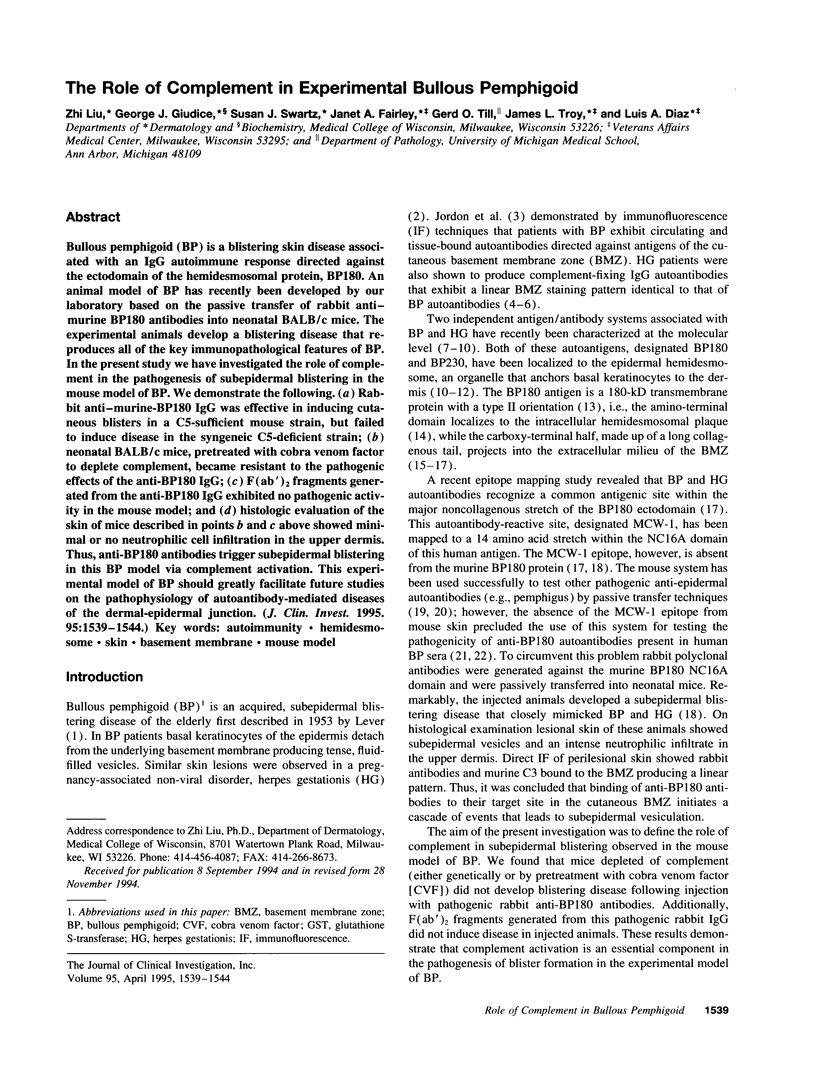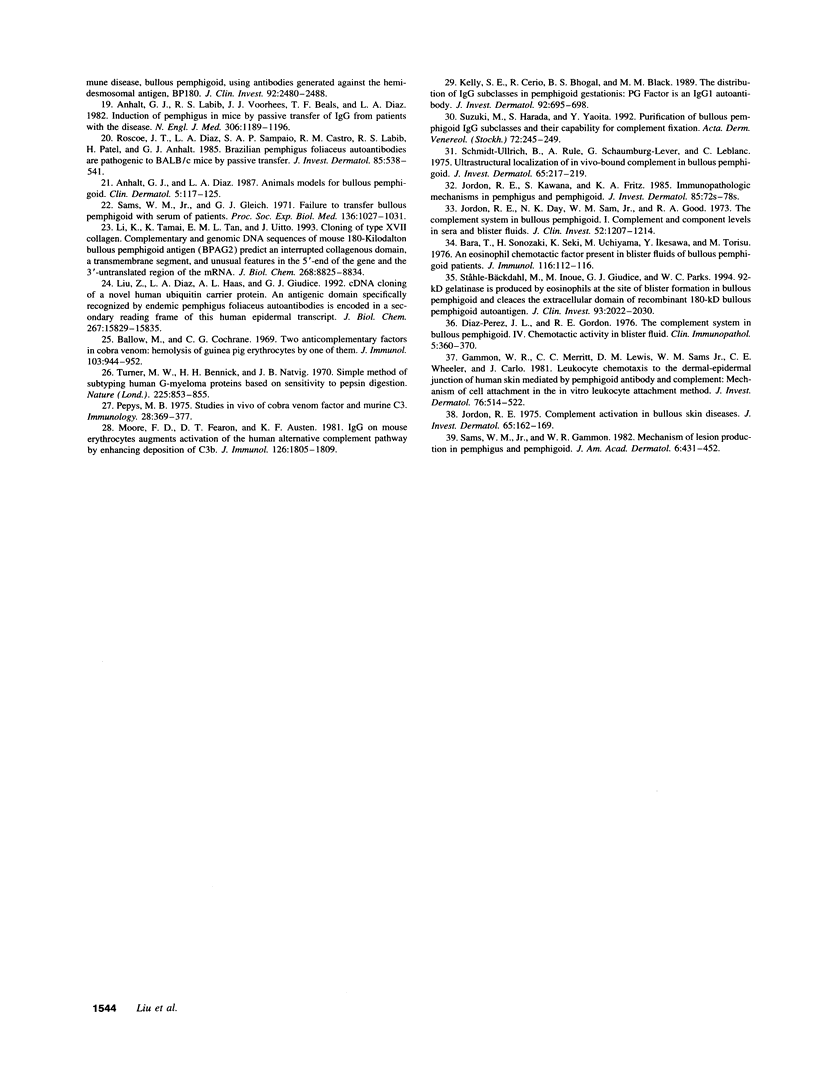Abstract
Bullous pemphigoid (BP) is a blistering skin disease associated with an IgG autoimmune response directed against the ectodomain of the hemidesmosomal protein, BP180. An animal model of BP has recently been developed by our laboratory based on the passive transfer of rabbit antimurine BP180 antibodies into neonatal BALB/c mice. The experimental animals develop a blistering disease that reproduces all of the key immunopathological features of BP. In the present study we have investigated the role of complement in the pathogenesis of subepidermal blistering in the mouse model of BP. We demonstrate the following. (a) Rabbit anti-murine-BP180 IgG was effective in inducing cutaneous blisters in a C5-sufficient mouse strain, but failed to induce disease in the syngeneic C5-deficient strain; (b) neonatal BALB/c mice, pretreated with cobra venom factor to deplete complement, became resistant to the pathogenic effects of the anti-BP180 IgG; (c) F(ab')2 fragments generated from the anti-BP180 IgG exhibited no pathogenic activity in the mouse model; and (d) histologic evaluation of the skin of mice described in points b and c above showed minimal or no neutrophilic cell infiltration in the upper dermis. Thus, anti-BP180 antibodies trigger subepidermal blistering in this BP model via complement activation. This experimental model of BP should greatly facilitate future studies on the pathophysiology of autoantibody-mediated diseases of the dermal-epidermal junction.
Full text
PDF





Images in this article
Selected References
These references are in PubMed. This may not be the complete list of references from this article.
- Anhalt G. J., Diaz L. A. Animal models for bullous pemphigoid. Clin Dermatol. 1987 Jan-Mar;5(1):117–125. doi: 10.1016/0738-081x(87)90056-3. [DOI] [PubMed] [Google Scholar]
- Anhalt G. J., Labib R. S., Voorhees J. J., Beals T. F., Diaz L. A. Induction of pemphigus in neonatal mice by passive transfer of IgG from patients with the disease. N Engl J Med. 1982 May 20;306(20):1189–1196. doi: 10.1056/NEJM198205203062001. [DOI] [PubMed] [Google Scholar]
- Baba T., Sonozaki H., Seki K., Uchiyama M., Ikesawa Y., Toriisu M. An eosinophil chemotactic factor present in blister fluids of bullous pemphigoid patients. J Immunol. 1976 Jan;116(1):112–116. [PubMed] [Google Scholar]
- Ballow M., Cochrane C. G. Two anticomplementary factors in cobra venom: hemolysis of guinea pig erythrocytes by one of them. J Immunol. 1969 Nov;103(5):944–952. [PubMed] [Google Scholar]
- Diaz-Perez J. L., Jordon R. E. The complement system in bullous pemphigoid. IV. Chemotactic activity in blister fluid. Clin Immunol Immunopathol. 1976 May;5(3):360–370. doi: 10.1016/0090-1229(76)90045-3. [DOI] [PubMed] [Google Scholar]
- Diaz L. A., Ratrie H., 3rd, Saunders W. S., Futamura S., Squiquera H. L., Anhalt G. J., Giudice G. J. Isolation of a human epidermal cDNA corresponding to the 180-kD autoantigen recognized by bullous pemphigoid and herpes gestationis sera. Immunolocalization of this protein to the hemidesmosome. J Clin Invest. 1990 Oct;86(4):1088–1094. doi: 10.1172/JCI114812. [DOI] [PMC free article] [PubMed] [Google Scholar]
- Gammon W. R., Merritt C. C., Lewis D. M., Sams W. M., Jr, Wheeler C. E., Jr, Carlo J. Leukocyte chemotaxis to the dermal-epidermal junction of human skin mediated by pemphigoid antibody and complement: mechanism of cell attachment in the in vitro leukocyte attachment method. J Invest Dermatol. 1981 Jun;76(6):514–522. doi: 10.1111/1523-1747.ep12521246. [DOI] [PubMed] [Google Scholar]
- Giudice G. J., Emery D. J., Diaz L. A. Cloning and primary structural analysis of the bullous pemphigoid autoantigen BP180. J Invest Dermatol. 1992 Sep;99(3):243–250. doi: 10.1111/1523-1747.ep12616580. [DOI] [PubMed] [Google Scholar]
- Giudice G. J., Emery D. J., Zelickson B. D., Anhalt G. J., Liu Z., Diaz L. A. Bullous pemphigoid and herpes gestationis autoantibodies recognize a common non-collagenous site on the BP180 ectodomain. J Immunol. 1993 Nov 15;151(10):5742–5750. [PubMed] [Google Scholar]
- Giudice G. J., Squiquera H. L., Elias P. M., Diaz L. A. Identification of two collagen domains within the bullous pemphigoid autoantigen, BP180. J Clin Invest. 1991 Feb;87(2):734–738. doi: 10.1172/JCI115054. [DOI] [PMC free article] [PubMed] [Google Scholar]
- Hopkinson S. B., Riddelle K. S., Jones J. C. Cytoplasmic domain of the 180-kD bullous pemphigoid antigen, a hemidesmosomal component: molecular and cell biologic characterization. J Invest Dermatol. 1992 Sep;99(3):264–270. doi: 10.1111/1523-1747.ep12616615. [DOI] [PubMed] [Google Scholar]
- Jordon R. E., Beutner E. H., Witebsky E., Blumental G., Hale W. L., Lever W. F. Basement zone antibodies in bullous pemphigoid. JAMA. 1967 May 29;200(9):751–756. [PubMed] [Google Scholar]
- Jordon R. E. Complement activation in bullous skin diseases. J Invest Dermatol. 1975 Jul;65(1):162–169. doi: 10.1111/1523-1747.ep12598113. [DOI] [PubMed] [Google Scholar]
- Jordon R. E., Day N. K., Sams W. M., Jr, Good R. A. The complement system in bullous pemphigoid. I. Complement and component levels in sera and blister fluids. J Clin Invest. 1973 May;52(5):1207–1214. doi: 10.1172/JCI107288. [DOI] [PMC free article] [PubMed] [Google Scholar]
- Jordon R. E., Heine K. G., Tappeiner G., Bushkell L. L., Provost T. T. The immunopathology of herpes gestationis. Immunofluorescence studies and characterization of "HG factor". J Clin Invest. 1976 Jun;57(6):1426–1431. doi: 10.1172/JCI108412. [DOI] [PMC free article] [PubMed] [Google Scholar]
- Jordon R. E., Kawana S., Fritz K. A. Immunopathologic mechanisms in pemphigus and bullous pemphigoid. J Invest Dermatol. 1985 Jul;85(1 Suppl):72s–78s. doi: 10.1111/1523-1747.ep12275497. [DOI] [PubMed] [Google Scholar]
- Katz S. I., Hertz K. C., Yaoita H. Herpes gestationis. Immunopathology and characterization of the HG factor. J Clin Invest. 1976 Jun;57(6):1434–1441. doi: 10.1172/JCI108413. [DOI] [PMC free article] [PubMed] [Google Scholar]
- Kelly S. E., Cerio R., Bhogal B. S., Black M. M. The distribution of IgG subclasses in pemphigoid gestationis: PG factor is an IgG1 autoantibody. J Invest Dermatol. 1989 May;92(5):695–698. doi: 10.1111/1523-1747.ep12696884. [DOI] [PubMed] [Google Scholar]
- LEVER W. F. Pemphigus. Medicine (Baltimore) 1953 Feb;32(1):1–123. doi: 10.1097/00005792-195302000-00001. [DOI] [PubMed] [Google Scholar]
- Labib R. S., Anhalt G. J., Patel H. P., Mutasim D. F., Diaz L. A. Molecular heterogeneity of the bullous pemphigoid antigens as detected by immunoblotting. J Immunol. 1986 Feb 15;136(4):1231–1235. [PubMed] [Google Scholar]
- Li K., Tamai K., Tan E. M., Uitto J. Cloning of type XVII collagen. Complementary and genomic DNA sequences of mouse 180-kilodalton bullous pemphigoid antigen (BPAG2) predict an interrupted collagenous domain, a transmembrane segment, and unusual features in the 5'-end of the gene and the 3'-untranslated region of the mRNA. J Biol Chem. 1993 Apr 25;268(12):8825–8834. [PubMed] [Google Scholar]
- Liu Z., Diaz L. A., Haas A. L., Giudice G. J. cDNA cloning of a novel human ubiquitin carrier protein. An antigenic domain specifically recognized by endemic pemphigus foliaceus autoantibodies is encoded in a secondary reading frame of this human epidermal transcript. J Biol Chem. 1992 Aug 5;267(22):15829–15835. [PubMed] [Google Scholar]
- Liu Z., Diaz L. A., Troy J. L., Taylor A. F., Emery D. J., Fairley J. A., Giudice G. J. A passive transfer model of the organ-specific autoimmune disease, bullous pemphigoid, using antibodies generated against the hemidesmosomal antigen, BP180. J Clin Invest. 1993 Nov;92(5):2480–2488. doi: 10.1172/JCI116856. [DOI] [PMC free article] [PubMed] [Google Scholar]
- Moore F. D., Jr, Fearon D. T., Austen K. F. IgG on mouse erythrocytes augments activation of the human alternative complement pathway by enhancing deposition of C3b. J Immunol. 1981 May;126(5):1805–1809. [PubMed] [Google Scholar]
- Morrison L. H., Labib R. S., Zone J. J., Diaz L. A., Anhalt G. J. Herpes gestationis autoantibodies recognize a 180-kD human epidermal antigen. J Clin Invest. 1988 Jun;81(6):2023–2026. doi: 10.1172/JCI113554. [DOI] [PMC free article] [PubMed] [Google Scholar]
- Mutasim D. F., Takahashi Y., Labib R. S., Anhalt G. J., Patel H. P., Diaz L. A. A pool of bullous pemphigoid antigen(s) is intracellular and associated with the basal cell cytoskeleton-hemidesmosome complex. J Invest Dermatol. 1985 Jan;84(1):47–53. doi: 10.1111/1523-1747.ep12274684. [DOI] [PubMed] [Google Scholar]
- Nishizawa Y., Uematsu J., Owaribe K. HD4, a 180 kDa bullous pemphigoid antigen, is a major transmembrane glycoprotein of the hemidesmosome. J Biochem. 1993 Apr;113(4):493–501. doi: 10.1093/oxfordjournals.jbchem.a124072. [DOI] [PubMed] [Google Scholar]
- Pepys M. B. Studies in vivo of cobra factor and murine C3. Immunology. 1975 Feb;28(2):369–377. [PMC free article] [PubMed] [Google Scholar]
- Provost T. T., Tomasi T. B., Jr Evidence for complement activation via the alternate pathway in skin diseases, I. Herpes gestationis, systemic lupus erythematosus, and bullous pemphigoid. J Clin Invest. 1973 Jul;52(7):1779–1787. doi: 10.1172/JCI107359. [DOI] [PMC free article] [PubMed] [Google Scholar]
- Roscoe J. T., Diaz L., Sampaio S. A., Castro R. M., Labib R. S., Takahashi Y., Patel H., Anhalt G. J. Brazilian pemphigus foliaceus autoantibodies are pathogenic to BALB/c mice by passive transfer. J Invest Dermatol. 1985 Dec;85(6):538–541. doi: 10.1111/1523-1747.ep12277362. [DOI] [PubMed] [Google Scholar]
- Sams W. M., Jr, Gammon W. R. Mechanism of lesion production in pemphigus and pemphigoid. J Am Acad Dermatol. 1982 Apr;6(4 Pt 1):431–452. doi: 10.1016/s0190-9622(82)70036-2. [DOI] [PubMed] [Google Scholar]
- Sams W. M., Jr, Gleich G. J. Failure to transfer bullous pemphigoid with serum from patients. Proc Soc Exp Biol Med. 1971 Apr;136(4):1027–1031. doi: 10.3181/00379727-136-35421. [DOI] [PubMed] [Google Scholar]
- Schmidt-Ullrich B., Rule A., Schaumburg-Lever G., Leblanc C. Ultrastructural localization of in vivo-bound complement in bullous pemphigoid. J Invest Dermatol. 1975 Aug;65(2):217–219. doi: 10.1111/1523-1747.ep12598218. [DOI] [PubMed] [Google Scholar]
- Shornick J. K., Bangert J. L., Freeman R. G., Gilliam J. N. Herpes gestationis: clinical and histologic features of twenty-eight cases. J Am Acad Dermatol. 1983 Feb;8(2):214–224. doi: 10.1016/s0190-9622(83)70027-7. [DOI] [PubMed] [Google Scholar]
- Stanley J. R., Tanaka T., Mueller S., Klaus-Kovtun V., Roop D. Isolation of complementary DNA for bullous pemphigoid antigen by use of patients' autoantibodies. J Clin Invest. 1988 Dec;82(6):1864–1870. doi: 10.1172/JCI113803. [DOI] [PMC free article] [PubMed] [Google Scholar]
- Ståhle-Bäckdahl M., Inoue M., Guidice G. J., Parks W. C. 92-kD gelatinase is produced by eosinophils at the site of blister formation in bullous pemphigoid and cleaves the extracellular domain of recombinant 180-kD bullous pemphigoid autoantigen. J Clin Invest. 1994 May;93(5):2022–2030. doi: 10.1172/JCI117196. [DOI] [PMC free article] [PubMed] [Google Scholar]
- Suzuki M., Harada S., Yaoita H. Purification of bullous pemphigoid IgG subclasses and their capability for complement fixation. Acta Derm Venereol. 1992 Aug;72(4):245–249. [PubMed] [Google Scholar]
- Tanaka T., Korman N. J., Shimizu H., Eady R. A., Klaus-Kovtun V., Cehrs K., Stanley J. R. Production of rabbit antibodies against carboxy-terminal epitopes encoded by bullous pemphigoid cDNA. J Invest Dermatol. 1990 May;94(5):617–623. doi: 10.1111/1523-1747.ep12876200. [DOI] [PubMed] [Google Scholar]
- Turner M. W., Bennich H. H., Natvig J. B. Simple method of subtyping human G-myeloma proteins based on sensitivity to pepsin digestion. Nature. 1970 Feb 28;225(5235):853–855. doi: 10.1038/225853b0. [DOI] [PubMed] [Google Scholar]






